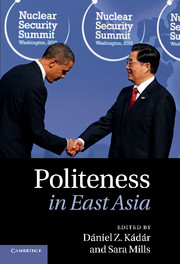Book contents
- Frontmatter
- Contents
- Notes on contributors
- Foreword
- Acknowledgements
- Abbreviations
- 1 Introduction
- Part I Politeness in East Asia: Theory
- Part II Politeness in East Asia: Practice
- 6 Politeness in China
- 7 Politeness in Japan
- 8 Politeness in Korea
- 9 Politeness in Vietnam
- 10 Politeness in Singapore
- 11 Epilogue: Culture and norms in politeness research
- Notes
- Bibliography
- Index
6 - Politeness in China
from Part II - Politeness in East Asia: Practice
Published online by Cambridge University Press: 07 September 2011
- Frontmatter
- Contents
- Notes on contributors
- Foreword
- Acknowledgements
- Abbreviations
- 1 Introduction
- Part I Politeness in East Asia: Theory
- Part II Politeness in East Asia: Practice
- 6 Politeness in China
- 7 Politeness in Japan
- 8 Politeness in Korea
- 9 Politeness in Vietnam
- 10 Politeness in Singapore
- 11 Epilogue: Culture and norms in politeness research
- Notes
- Bibliography
- Index
Summary
Introduction
Foreign learners of Chinese often find themselves in a somewhat disturbing situation when it comes to politeness: the Chinese are represented, and often represent themselves, in two entirely different stereotypical ways, that is, being either ‘traditionally polite’ or ‘direct and pragmatic’ (cf. Chapter 2 in the present volume). And, upon visiting China they may experience these extremes in practice: whilst people in daily encounters may not bother to show too much politeness by Western standards, when invited to a family they will be treated in a deferential way that seems ‘typically Chinese’ for many Westerners. The aim of the present chapter is to shed light on the reason for this ambiguity by introducing the reader to the norms and, perhaps more importantly, the discursive practices of politeness in modern and contemporary China.
Surveying Chinese politeness is not an easy task, as this field has been extensively studied, and because the development of Chinese politeness norms has a complex history. In fact, talking about ‘several-millennia-long’ Chinese politeness, which frequently happens in the research literature, is unacceptable, as it is a nationalistic/‘Orientalist’ stereotype (cf. Kádár, 2007a), since in the last two centuries there have been large-scale changes and the historical and contemporary Chinese practices of politeness have some saliently different features, as will also be demonstrated by the present chapter. Yet, whilst it is necessary to demystify the ideology of the Chinese ‘politeness heritage’, one must nevertheless be aware of the history of Chinese politeness norms when summarising the peculiarities of modern Chinese im/politeness behaviour, in particular the above-mentioned behavioural ambiguity.
- Type
- Chapter
- Information
- Politeness in East Asia , pp. 125 - 146Publisher: Cambridge University PressPrint publication year: 2011
- 12
- Cited by

